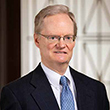Monetary Policy: The Early Years
The Fed's founders did not conceive of monetary policy in the modern sense of taking actions to influence interest rates, credit conditions or the growth of the money supply to achieve broad macroeconomic policy goals, such as price stability and maximum employment. The founders expected the Reserve banks to set their discount rates at levels that would enable member banks to satisfy their customers' demands for currency and short-term agricultural and business loans. First and foremost, however, Reserve banks were expected to protect their own reserve positions. Reserve banks were required to hold gold reserves worth at least 40 percent of their outstanding note issues and 35 percent of their deposit liabilities. A Reserve bank could increase its reserve ratio by raising its discount rate. Doing so would discourage member banks from borrowing at the Reserve bank's discount window, thereby reducing the Reserve bank's note and deposit liabilities relative to its gold reserves. Of course, if a Reserve bank set its discount rate too high, then it would neither fulfill its mission of accommodating the currency and credit needs of its district, nor generate income to cover the bank's expenses.2
Almost as an afterthought, the Federal Reserve Act authorized Reserve banks to purchase government securities in the open market. In modern times, such open market operations in government securities have been the principal means by which the Fed conducts monetary policy. However, it was not until the 1920s that the Reserve banks began to coordinate their open market operations with one another or to use them to achieve macroeconomic policy objectives, such as price stability and stable economic growth—that is, to conduct monetary policy.3
The Fed's first attempts at macroeconomic stabilization were apparently successful. In their classic study, A Monetary History of the United States, 1867-1960, economists Milton Friedman and Anna J. Schwartz contended that under the leadership of New York Fed Gov. Benjamin Strong, the Fed pursued policies that moderated the business cycle and maintained price stability.4 Friedman and Schwartz argued that the Fed's decentralized structure necessitated a forceful leader like Strong to formulate a coherent monetary policy. Strong's death in 1928 robbed the System of a forceful leader; the loss, Friedman and Schwartz contended, caused policy to disintegrate under the weight of petty jealousies, parochialism and infighting among the individual Reserve banks and between the Reserve banks and the Board. The consequence was disastrous, as the System failed to respond to banking panics or to prevent a sharp economic contraction during the Great Depression of the 1930s.
From this perspective, a lesson of the Great Depression would seem to be that decision-making authority should be concentrated within a single, small group whose members share common goals and understanding of policy. Marriner Eccles, whom President Franklin Roosevelt appointed to be governor of the Board in 1933, thought so. Eccles argued that the Board should have the sole responsibility for monetary policy and advocated legislation to reduce or eliminate the role of the Reserve banks in monetary policymaking. Congress did not go as far as Eccles desired, but the Banking Act of 1935 shifted the balance of power in monetary policymaking away from the Reserve banks to the Board.5

William McChesney Martin Sr. (left) served as the first chairman of the St. Louis Fed's board of directors until 1929, when he became its governor (CEO). His son, William McChesney Martin Jr. (right), was the longest-tenured chairman of the Federal Reserve System, serving from 1951 to 1970.
Not all histories view the Fed's decentralized structure or the death of Benjamin Strong as being as significant as did Friedman and Schwartz. Economist and Fed historian Allan Meltzer, for example, argued that Strong's policy framework was flawed because it relied on potentially misleading indicators of monetary conditions, such as nominal interest rates (as opposed to interest rates adjusted for expected inflation). Strong's successor at the New York Fed, George Harrison, usually advocated a more vigorous response to the Depression than did the other Reserve bank governors, including William McChesney Martin Sr. of the St. Louis Fed. However, Meltzer contended that the principal reason for the Fed's policy mistakes in the 1930s stemmed from a lack of understanding about policy, rather than the Fed's structure.6
ENDNOTES
2. The Fed has never received a congressional appropriation and has always depended on its income to cover expenses and pay dividends to its member banks. In the early days, earnings were a big concern, but over time, Fed officials understood that maximizing revenue or profits was not an appropriate criterion for conducting policy. See Meltzer (p. 78) for a discussion about the Fed's concern over earnings during the System's first years.
3. The Fed's "discovery" of open market operations and development of a monetary policy in the 1920s is discussed in Chandler, Friedman and Schwartz, Meltzer and references therein.
4. Before 1936, the chief executive officers of the Federal Reserve banks held the title of "governor," as did the chairman of the Federal Reserve Board. (Other members of the Board were simply referred to as "members" of the Board.) The Banking Act of 1935 designated all members of the Board as governors (and changed the name of the Board to the Board of Governors) and changed the title of the chief executive officers of the Reserve banks to "president."
5. See Meltzer (pp. 467-86) on Eccles' views and the legislative history of the Banking Act of 1935.
6. See also Wheelock (1991, 1992) and references therein for more information about the Fed's policy goals and strategy during the 1920s and early 1930s.



